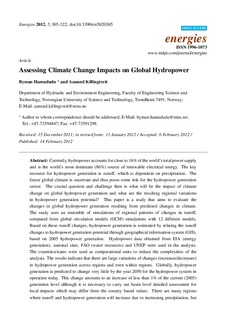Assessing Climate Change Impacts on Global Hydropower
Journal article, Peer reviewed
Permanent lenke
http://hdl.handle.net/11250/2364777Utgivelsesdato
2012Metadata
Vis full innførselSamlinger
Sammendrag
Currently, hydropower accounts for close to 16% of the world’s total power supply and is the world’s most dominant (86%) source of renewable electrical energy. The key resource for hydropower generation is runoff, which is dependent on precipitation. The future global climate is uncertain and thus poses some risk for the hydropower generation sector. The crucial question and challenge then is what will be the impact of climate change on global hydropower generation and what are the resulting regional variations in hydropower generation potential? This paper is a study that aims to evaluate the changes in global hydropower generation resulting from predicted changes in climate. The study uses an ensemble of simulations of regional patterns of changes in runoff, computed from global circulation models (GCM) simulations with 12 different models. Based on these runoff changes, hydropower generation is estimated by relating the runoff changes to hydropower generation potential through geographical information system (GIS), based on 2005 hydropower generation. Hydropower data obtained from EIA (energy generation), national sites, FAO (water resources) and UNEP were used in the analysis. The countries/states were used as computational units to reduce the complexities of the analysis. The results indicate that there are large variations of changes (increases/decreases) in hydropower generation across regions and even within regions. Globally, hydropower generation is predicted to change very little by the year 2050 for the hydropower system in operation today. This change amounts to an increase of less than 1% of the current (2005) generation level although it is necessary to carry out basin level detailed assessment for local impacts which may differ from the country based values. There are many regions where runoff and hydropower generation will increase due to increasing precipitation, but also many regions where there will be a decrease. Based on this evaluation, it has been concluded that even if individual countries and regions may experience significant impacts, climate change will not lead to significant changes in the global hydropower generation, at least for the existing hydropower system.
